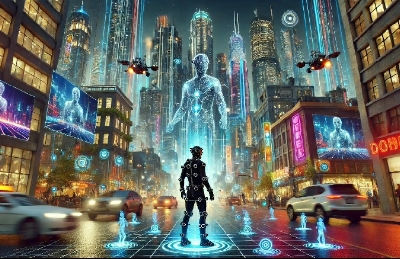This post was published by a guest. The views expressed are those of the author and do not necessarily reflect the views of Scified.com.
A silent revolution is transforming the cinematic world: AI-driven special effects. Beyond their thrilling narratives, science fiction films captivate audiences with groundbreaking technology. The integration of many trending AI tools has revolutionized various industries by significantly enhancing creative processes and outcomes.
Whether it's generating lifelike CGI characters or creating immersive environments, tools like DeepArt's neural network are pushing the boundaries of what technology can achieve, making the impossible seem real.
The Rise of AI in Visual Effects
Integrating artificial intelligence in visual effects (VFX) has been a transformative force in filmmaking. AI algorithms analyze vast amounts of data and automate complex processes, significantly reducing the time and effort required to produce high-quality effects. This advancement has democratized access to sophisticated VFX, allowing filmmakers of all scales to create intricate and realistic scenes. These innovations are not only revolutionizing film but also enhancing sci-fi gaming titles by providing more immersive and life-like visuals.
A prime example of AI's impact is in motion capture technology. Traditionally, motion capture required actors to don suits with sensors to track their movements. AI has streamlined this process, enabling advanced systems to track and replicate human movements with minimal equipment, resulting in more natural and fluid animations.
Enhancing Realism with AI
AI-driven tools are elevating the realism of special effects in sci-fi films. Machine learning algorithms generate highly detailed textures and models, making CGI characters and environments look astonishingly lifelike.
For instance, DeepMotion uses neural networks to create realistic character animations, adding a new level of authenticity to on-screen performances. This same technology is also applied to sci-fi gaming titles, offering gamers unprecedented visual fidelity and realism.
Moreover, AI is revolutionizing the rendering process. Traditional rendering methods can be time-consuming and resource-intensive.
AI-based solutions like NVIDIA's OptiX leverage deep learning to accelerate rendering, producing high-quality images in a fraction of the time. This allows filmmakers to experiment with more complex scenes and achieve unparalleled visual fidelity.
Revolutionizing Storytelling
Beyond visual effects, AI is transforming storytelling in sci-fi films. AI algorithms can analyse scripts and suggest improvements, aiding writers in crafting more engaging and coherent narratives. Additionally, AI-driven tools assist in pre-visualization, enabling directors to plan and visualise scenes before filming begins.
This leads to more efficient production schedules and enhanced storytelling. These storytelling advancements also influence the narrative complexity of sci-fi gaming titles, allowing for more prosperous and immersive gameplay experiences.
Generative adversarial networks (GANs) offer an exciting application of AI in storytelling. GANs create new visuals based on set parameters, allowing filmmakers to generate unique and imaginative worlds. Films like "The Matrix Resurrections" have utilized AI-generated visuals to create stunning digital landscapes.
Case Studies: AI in Modern Sci-Fi Films
Several modern sci-fi films have successfully harnessed AI-driven special effects to enhance their storytelling. "Blade Runner 2049" used AI to create its dystopian future cityscapes, with the VFX team employing AI algorithms to generate realistic environments complete with dynamic lighting and weather effects.
Similarly, "Avengers: Endgame" leveraged AI technology for epic battle scenes. The film’s VFX team used AI to manage the complex interactions between hundreds of characters, ensuring realistic movement and behavior. Achieving this level of detail would have been nearly impossible without AI-driven tools.
The Future of AI in Sci-Fi Cinema
As AI technology advances, its impact on sci-fi cinema will only grow. Future developments in AI-driven special effects will likely include even more sophisticated motion capture systems, enhanced rendering techniques, and intuitive storytelling tools. These innovations will empower filmmakers to push the boundaries of their creativity and deliver even more immersive and captivating sci-fi experiences.
Furthermore, the democratization of AI tools means that independent filmmakers will have access to the same advanced technology as significant studios. This will level the playing field and lead to a more diverse range of sci-fi films, each with its unique visual style and narrative approach.
Conclusion
AI-driven special effects are reshaping the landscape of modern sci-fi films. By enhancing the realism of visual effects and revolutionizing storytelling, AI tools enable filmmakers to create more immersive and visually stunning experiences. As technology continues to evolve, the future of sci-fi cinema promises even more exciting innovations, making it an incredibly thrilling time for creators and audiences alike.

The Impact That Sci-Fi Has Had on the Slot Gaming World
Science fiction has long been a source of inspiration across entertainment, from films and television to literature and video games. In recent years, ...

Loans for Delinquent Borrowers: Yes, You Still Have Options
Financial setbacks can derail even the most responsible individuals. Missed payments, fluctuating income, unexpected emergencies, or accumulated debt ...

Overseas Gift Lending Account: A Smart Choice for Cross-Border Support
In an era defined by globalization and digital connectivity, the concept of an Overseas Gift Lending Account has emerged as a vital financial tool for...

5 Best Pennsylvania Casino Apps for Real Money in 2025
Mobile gaming has completely transformed downtime. Pennsylvania casino apps let you play slots, hit the blackjack tables, or spin roulette w...

Address Collection: Modern Methods for Accurate Data Capture
Accurate address collection has become a mission-critical necessity for organizations that rely on precise customer information to streamline logistic...


